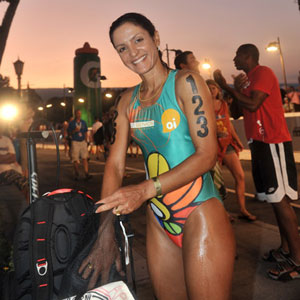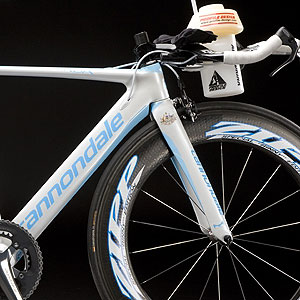The Women of Kona

If you simply look at finish times, it might seem that just about all of the performance evolution at the Hawaiian Ironman occurred by 1989 in the men's race, and by 1992 among the women. Since then an occasional record has been set in the overall finish time, or per event leg, but those new records are rare, and are set by bare increments.
But there has been a change, and quite a dramatic one, in the women's race. While the swim times have remained about the same for the best handful of overall triathletes in the women's field, the cycling times have gone in one direction and the run times in the other. This trend is not a blip or an anomaly, but is demonstrable over the past several years.
Consider three consecutive years in Kona, 1992 through 1994. The top-5 overall female pros were, as an average, a reliable time gap behind the top-5 men in their bike splits, always between 27 and 28 minutes (that is to say, if the top-5 men overall averaged a bike split of 4:35, you could bet the top-5 women would ride an average split of 5:02 or 5:03).
The women were also a reliable distance behind the men in the run: 28 minutes in '92; 25 minutes the next year; 31 minutes in 1994. So, if the men averaged 2:50, the women would run, on average, about 3:20, more or less.
In the three most recent years ending with the '09 Hawaiian Ironman, the women were 37, 37 and 32 minutes behind the men in the bike. If you give Ms. Wellington's 10 minutes off the bike in '08 back to her, those gaps in minutes are 37, 35 and 32. Simply put, the women have given up considerable time to the men on the bike over the past generation.
But what they've lost on the bike they've more than made up for in the run. The differential from the men are between 12 and 15 minutes each year between 2007 and 2009. They've halved the gap between themselves and the men, relative to those racing almost two decades ago.
The swim times for the women racing between 1992 and 1994 are about even with those racing today: the top-5 overall women swam as an average about 57 or 58 minutes both then and now.
How does this factor in overall times? The men, during these three years a generation ago, averaged 8:22 throughout the top-5, and this included the horrific-weather '94 year. During the most recent three-year span the men have also averaged 8:22.
For the women it's a different story. Those of yesteryear averaged finishes within seconds of 9:24:30, and the women of today are faster, with finishes averaging 9:18:30.
These women are slower on the bike, the same on the swim, and faster on the run, than the women of a generation ago. But, they're enough faster on the run to have cut the interval from the leading men down to 56 minutes from 62 minutes.
The men's swim, bike and run times, as a percentage of their overall races, have not changed much in the past generation. But womens racing has evolved entirely, to marathon splits that would be unheard of a decade ago. The top 7 women's Kona marathon splits of the entire decade of the '90s averaged 3:04. In the 2008 Hawaiian Ironman race alone, the 7 best women's marathon splits averaged 3:04!
Why this change in focus from the bike to the run? First, I think it's instructive to remember the changes in women's racing. The sport today is, in total participant numbers, probably triple the size it was in during the 92 thru 94 seasons. Second, the number of women taking part in triathlons, at least in the United States, has grown from roughly 15% in that era to 35% now. So, there are probably quintuple the number of women in triathlon now versus back in the early-to-mid '90s. Maybe more.
But this growth in numbers, which certainly adds to the pool of available talent in the women's field, is only enough to explain the improvement in overall times, not the change in focus from bike to run.
There are four possibilities that I can see that explain the shift in sport emphasis.
1. Maybe the women understand something that the men don't: that everyone was riding too fast and running too slow. But I don't think the men would ever buy into that, because we've had cases where a Greg Welch, Chris McCormack, Lothar Leder, Christian Bustos, would lay off the bike pace and try to run to the win. Macca, Crowie and Welchie learned that only by riding no slower than even with the main pack of leading men could they hope to prevail with their superior runs.
2. Maybe the women were riding too fast in the "old days," even if the men were not; that their best bike pace is a bit slower, allowing for their runs to more than compensate for laying off the bike pace. The problem with this theory is that only twice, after 1997, has the women's winner of the Hawaiian Ironman not won while leading at T2. In other words, while the men's race is only occasionally won off the bike, the women's race is nearly always won off the bike.
3. We have a split-start now, with the age groups leaving 15 minutes behind the pros. In recent years, the age-group men have been less of a factor on the pro women during the bike. If you start AG men 15 minutes behind the pro women's race, this lack of bike traffic slows down the women's times.
4. The federation feeder system. We've now had three Olympic Games in triathlon, which means we've had 12 years worth of Olympic preparation, federation money to win medals, more or less evenly split among men and women. The focus during this time has been on those with footspeed. Footspeed wins World Cups, footspeed wins Olympic medals.
I think it's a little #3 and a lot of #4. In the current Hawaiian Ironman, four of the top five women came out of the federation system, with a history of ITU and World Cup racing. Only third place, Spain's Virginia Berasategui, developed as a no-draft, long course specialist.
Accordingly, the long course element of our sport has benefited from this short-to-long migration, just as road running and marathoning is dominated by former track and field stars. And this is as it should be since, in horses and in humans, footspeed develops early, endurance late.
But does greater running ability necessarily mean slower cycling? I think not. World Cup racing will develop fast cyclists (note the success of World Cup athletes, men and women, in no-draft Olympic distance racing). But I don't know that the focus and expertise available to the women of a bygone generation are there to help those who turn from the World Cup to Ironman. The training, technology, tactics, expertise, you might patch together for 25 or even 56 miles might not be sufficient to last 112. Duct tape and bailing wire won't hold in Kona.
What is the take-away? That Paula Newby-Fraser, Natascha Badmann, Lori Bowden, Erin Baker, though as a group not as fast afoot as the women of today, might have something to teach these fleet-footed speedsters who currently dominate long coursing (the obvious exception is Ms. Wellington, who's absorbed most of what the stars of yesteryear could tell her). And about the cycling ability of those bygone stars, consider this: the average bike split in 1993 throughout the top 5 overall female finishers in Kona was, get ready, 4:58.
We have much more talent in triathlon now than we did 15 years ago, with many more women competing. And more coming our way, because of a career arc that starts at U23 or even younger, thru World Cup racing, the Olympic movement, and then the ability to actually make a season and a living out of half-Ironman racing (unheard of even a decade ago). Then, you move to the Ironman, with 23 prize money events worldwide instead of 7, and a plethora of 70.3 races to do in between your Ironmans. Life is good.
But it's a new technical, tactical, technological world when you move from World Cups to Ironman, and getting everything out of the bike leg you can in a no-draft, long-course event is not as simple as hopping off your R3 and onto a P3. I think the bike is, for a lot of upwardly mobile female World Cuppers, full of, to wax Rumsfeldian, unknown unknowns. Steve Hed, John Cobb, and so many others who were there to help and guide the long course women of yesteryear are now working with Pro Tour cyclists, and who can blame companies like Felt, Scott, Specialized, Trek, Cannondale, Cervelo, Kuota, and others if that's where their primary time and focus is too?
In baseball, we have the "5-tool" player: run, field, throw, hit for average, hit for power. If there is a 5-tool athlete found in Kona, maybe it's: swim, bike, run, manage heat, absorb fuel. Any female Kona racer who runs a 3:05 marathon and finishes in under 9:25 has the tools only God and her parents can give her. Assuming she comes from an ITU background, a :56 swim shouldn't be out of reach. Based on the numbers quoted above—and unless riding with AG men is a much bigger speed weapon than I comprehend—it appears the low hanging fruit is on the bike. That's the fifth tool.




Start the discussion at slowtwitch.northend.network